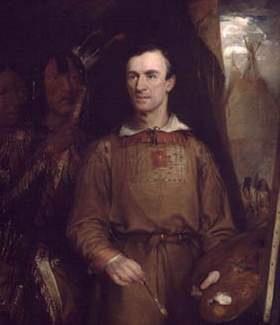George Catlin (George Catlin)

Artist. He is best remembered for his portraits of Native Americans in the Old West and is the first person to visually record Plains Indians in their native territory. He grew up in Pennsylvania and spent many hours hunting, fishing, and looking for American Indian artifacts. His fascination with Native Americans was kindled by his mother, who told him stories of the western frontier and how she was captured by a tribe when she was a young girl. His early work included engravings drawn from nature of sites along the route of the Erie Canal in New York State. Following a brief career as a lawyer, he produced two major collections of paintings of Native Americans and published a series of books chronicling his travels among the native peoples of North, Central and South America. Spurred by relics brought back by the famous Lewis and Clark Expedition of 1804 to 1806 which were owned by his friend, Charles Willson Peale, and claiming his interest in America’s ‘vanishing race’ that was sparked by a visiting American Indian delegation in Philadelphia, Pennsylvania, he set out to record the appearance and customs of America’s native peoples. He began his journey in 1830 when he accompanied famed explorer William Clark on a diplomatic mission up the Mississippi River into Native American territory. St. Louis, Missouri became his base of operations for five trips he took between 1830 and 1836, eventually visiting fifty tribes. Two years later he ascended the Missouri River to the Fort Union Trading Post, near what is now the North Dakota/Montana border, where he spent several weeks among indigenous people who were still relatively untouched by European civilization. He visited eighteen tribes, including the Pawnee, Omaha, and Ponca in the south and the Mandan, Hidatsa, Cheyenne, Crow, Assiniboine, and Blackfeet to the north, and there, he produced the most vivid and penetrating portraits of his career. During later trips along the Arkansas, Red and Mississippi rivers, as well as visits to Florida and the Great Lakes, he produced more than 500 paintings and gathered a substantial collection of artifacts. In 1838 he returned east and assembled the paintings and numerous artifacts into his Indian Gallery, and began delivering public lectures which drew on his good personal recollections of life among the Native Americans. He traveled with his Gallery to major cities such as Pittsburgh, Pennsylvania, Cincinnati, Ohio, and New York City, New York. Soon afterward he began a lifelong effort to sell his collection to the US government. The touring Gallery did not attract the paying public he needed to stay financially sound, and the Congress rejected his initial petition to purchase the works. In 1839 he took his collection across the Atlantic for a tour of European capitals. As a showman and entrepreneur, he initially attracted crowds to his Gallery in London, England, Brussels, Belgium and Paris, France. His continued attempts to persuade various officials in Washington DC to buy the collection failed. In 1852 he was forced to sell the original Gallery, now 607 paintings, due to personal debts. The industrialist Joseph Harrison acquired the paintings and artifacts, which he stored in a factory in Philadelphia, as security. In 1841 he published “Manners, Customs, and Condition of the North American Indians,” in two volumes, with about 300 engravings. Three years later he published 25 plates, entitled “Catlin’s North American Indian Portfolio” and in 1848, “Eight Years’ Travels and Residence in Europe.” He spent the last 20 years of his life trying to re-create his Gallery collection, and recreated over 400 paintings. This second collection of paintings is known as the “Cartoon Collection,” since the works are based on the outlines he drew of the works from the 1830s. From 1852 to 1857 he traveled through South and Central America and later returned for further exploration in the Far West. The record of these later years is contained in “Last Rambles amongst the Indians of the Rocky Mountains and the Andes” (1868) and “My Life among the Indians” (edited by N. G. Humphreys, 1909). In 1872 he traveled to Washington DC at the invitation of Joseph Henry, the first secretary of the Smithsonian Institution. Until his death in December of that year at the age of 76, he worked in a studio in the Smithsonian “Castle.” In 1879 Joseph Harrison’s widow donated the original Indian Gallery, more than 500 works, along with related artifacts, to the Smithsonian and the nearly complete surviving set of his first Gallery, painted in the 1830s, is now part of the Smithsonian American Art Museum’s collection. His associated artifacts are in the collections of the Department of Anthropology, National Museum of Natural History, at the Smithsonian. About 700 sketches are held by the American Museum of Natural History in New York City. Other artifacts of his are in the University of Pennsylvania Museum of Archaeology and Anthropology collections. The Huntington Library in San Marino, California also holds 239 of his illustrations of both North and South American Indians, as well as his illustrative and manuscript material. Noted author Larry McMurtry includes him as a character in his “The Berrybender Narratives” series of novels (2002 to 2004). In the historical novel “The Children of First Man” (1995), James Alexander Thom recreates the time he spent with the Mandan people. The 1970 film “A Man Called Horse” cites his work as one of the sources for its depiction of Lakota Sioux culture. (bio by: William Bjornstad) Family links: Parents: Polly Sutton Catlin (1770 – 1844) Spouse: Clara Bartlet Gregory Catlin (1807 – 1845) Children: Clara Gregory Catlin (1839 – 1895)* Siblings: George Catlin (1796 – 1872) Elizabeth Catlin Dart (1798 – 1865)* Mary Catlin Hartshorn (1802 – 1848)* John Catlin (1812 – 1834)* *Calculated relationship
Born
- July, 26, 1796
- USA
Died
- December, 12, 1872
- USA
Cemetery
- Green-Wood Cemetery
- USA

